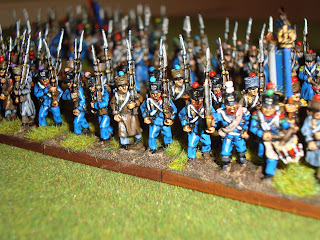The title says it all. Almost. 16 infantry battalions, 12 cannon and 4 cavalry regiments. Also 14 skirmisher bases and 8 officers (including brigade, divisional and Napoleon himself!)
20 skirmisher figures and I am entirely done. Well, there could always be more but I'm prepared to call 14 months of painting one project to a halt.
There are the cannon. A mixture of 6, 8 and 12 pdr guns. Foot and horse artillery.
My army represents the 8th Infantry Division of Ney's III Corps in 1813. Souham orignally commanded but after he was promoted Michel-Sylvestre Brayer commanded.
As the brigades in III Corps were quite large I haven't painted the entire division. I'm three battalions short of that. But given the beating III Corps took throughout 1813 it's no surprise all battalions were not present at all times. And that's what I wanted. I like painting the guys who do the bulk of the fighting. Not the elites but the conscripts.
Here is Francois Bony's brigade - 6 battalions. How can you not love that name in this period? This mostly consists of line battalions. I gave the senior battalion of the regiment a tricolour (so if the third and fourth are present I gave the tricolour to the third rather than a fanion.) Due to the army being in a rebuilding stage at this time the tricolour could easily pass to the most senior or complete battalion in the regiment at that time. The tricolour looks good so I wanted them in the field - and 1st brigade has only one 1st battalion among its numbers.
Above is Jean-Louis Charriere's brigade. This has four battalions of light infantry and two of line. I followed the same rules for lights and line in terms of figures. Only two of my battalions have "normal" uniforms. Most are a mix of greatcoat and uniforms - 50/50 - to show the nature of the French army in 1813. About a third have just greatcoat representing the "Marie Louise" conscripts.
This is my heavy brigade of cavalry - my armoured fist. Commanded by Etienne de Pommeroux - these were not attached to III Corps but could have easily been in ordered to that part of the field of battle. And again ... what a French name!
A little off centre but here are the latest painted. The Young Guard. I just had to have some for an 1813 army. Their numbers swelled and were used as a battering ram by Napoleon. This suits my style and my reasoning. Although Guard, these were not the pampered and little used Old and Middle Guard. These enthusiastic young men were repeatedly thrown into the most difficult and deadly situations time and again. A great reserve for my III Corps who stood in the thick of the action in a half dozen battles.
My Young Guard are all in their post Bardin reform uniforms. I know they should have some shabby uniforms and greatcoats too but I wanted my Guardsmen to just "pop." I'm not disappointed. As a block these guys look great. Ready to march into canister fire as the drums pound for the glory of empire and emperor.
Fanions provided some problems as sources state voltigeurs had red fanions but figure companies sell a range of other colours for Young Guard. I figured the first battalion should have red then I just chose something nice from there. I imagined Guard flags to be very colourful and gaudy.
As you can see Lacoste is in command of four battalions of Voltigeurs - a whole brigade of Young Guard - eager for the fray. I'd run these as more trained rather than veteran troops - but highly motivated.
And my lighter cavalry. I don't really have enough of these. Chasseurs and Dragoons. The III were supported by the Baden Dragoons and the 8th (or 9th?) Hussars. I didn't paint these as I wanted some cavalry more representative of the bulk of Napoleon's cavalry at the time - and there were large numbers of both dragoon and chasseur regiments - while allied cavalry and hussar numbers were falling due to attrition and cost. They fill in very well.
Here are some other pictures to mark the completion (mostly) of my French. What a relief! At times it was nothing but a chore while at other times a pleasure. I'm thrilled with the result - I was uncertain on the name tags at one stage but now I love the concept once more. I've done it with my other armies and it gives real character to your force (EG: Ha! You'll never stand up the the 1st battalion of the 22nd, you cad. Take this! - cried across the table as you send them in.)
The division commander (could be Corps commander like at Katzbach or Leipzig.)
Again, what a name!
Wonder if I'll ever put all on the table at once?
Vive France!



































